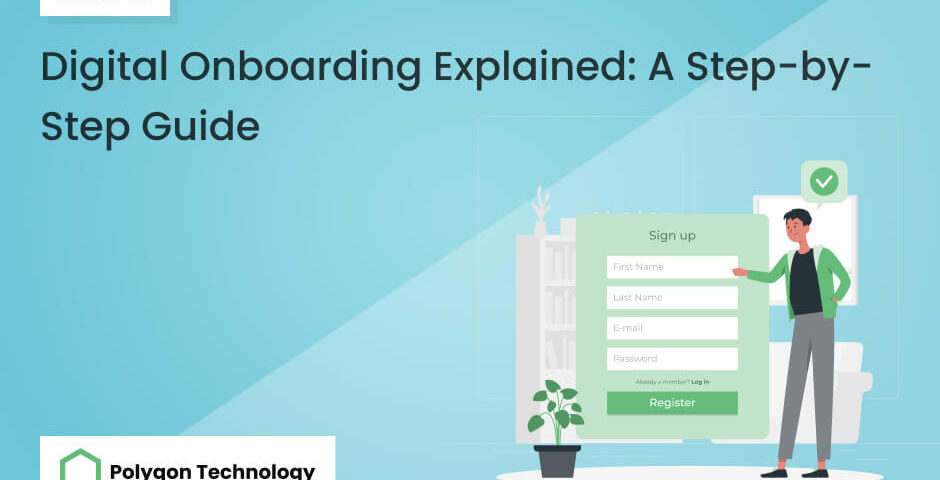
Digital Onboarding Explained: A Step-by-Step Guide
Digital Onboarding Explained: A Step-by-Step Guide

Sadman Sakib Khan
Sadman is a marketing professional and a fervent devotee of the ever-evolving world of marketing & technology. Possessing a knack for crafting compelling narratives, Sadman passionately engages in the creation of top-tier content in close partnership with esteemed subject matter experts.

Research shows that the digital onboarding process can boost conversion rates to around 50%. If companies decide not to use it, they end up retaining only around 40% of their potential consumers. So, it’s pretty obvious that onboarding consumers from their homes is a crucial move to improve your business procedures and keep your customers satisfied. But what exactly is digital onboarding?
Digital onboarding is an online procedure of bringing clients/users into a company or signing up new Clients/users for a service, all via their mobile devices. The main goal here is to double-check the identity of the person coming on board, making sure that they’re the individual they claim to be. In this article, you will get digital onboarding explained, so let’s dive in.
Digital Onboarding Overview
Digital onboarding, also called remote onboarding or account registration, is the process that states the way companies acquire or incorporate new customers online. It happens on apps or websites, not on-premises or in branches, making it a completely digital experience. In this process, you can sign up with a government service or company to use their services and products.
During onboarding, you need to share your ID and, if needed, biometric info such as a fingerprint or a face scan. With the digital onboarding procedure, a company can securely identify an individual. Though companies can use a mixture of client onboarding processes, digital onboarding has become more popular nowadays.
Remote service became famous after the COVID-19 pandemic. As per Business Leader, 67% of people now like using an app for regular banking rather than an in-person visit. If a company can’t offer a digital experience, it might lose lots of consumers to competitors who can offer it.
What Are The Main Types of Digital Onboarding?
Digital customer onboarding comes with various methods to select from to meet the needs of every company. Let me know them in detail.
Assisted Digital Onboarding
In the assisted digital onboarding process, the system will verify your customer in a real-time video call, where a KYC agent assesses the information. All your customer is required to do is display their documents in front of the camera so that it can capture those documents.
Automated Digital Onboarding
An onboarding process that is as easy as capturing a photo. The system captures photos of the customers and their documents. Then, the system does other onboarding procedures if required (such as facial recognition, liveliness detection, etc) and ensures a simple and quick customer experience.
Manual Digital Onboarding
This process enables customers and KYC agents to conduct the onboarding procedure conveniently. Customers submit their information online, and it can be verified at a later time.
NFC-Technology Based Digital Onboarding
This digital onboarding procedure utilizes the latest NFC technology to instantly validate data. It’s one of the most secure identity verification processes available right now. Anybody who has an NFC-compatible phone can access this digital onboarding procedure.
How Digital Onboarding Works
As it’s an online process of getting new customers on board, customers can effortlessly sign up for your service online. The digital onboarding procedure isn’t just user-friendly but also makes sure that it meets KYC standards. Now, let’s break down each step and take a closer look.
Customer Data Collection
Different companies may have varying steps for onboarding new customers. Take banking, for instance, where the digital onboarding process tends to be more stringent compared to other businesses. Typically, when new users sign up digitally, they need to provide a photograph of a government-issued ID, like a driver’s license.
At the same time, the system captures a picture of their face for comparison. The goal is to make it convenient for users to input their information.
Identity Verification
Banks and other industries consider identity verification an important step, which needs to follow the KYC (Know Your Customer) process. Now with digital onboarding, this time-consuming KYC can be done online, which is also known as eKYC. This usually involves advanced verification methods like biometric checks and document authentication, etc
Some services have even more serious verification procedures, which include extra checks for watchlists and AML (Anti-Money Laundering). For instance, banks often check into government-backed databases and assign a specific department to analyze user profiles.
After the user submits the necessary documents, the system then utilizes either a KYC agent, AI, or both to verify the documents. This process includes liveness checks, spoofing, and other features to prevent fraud.
Data Validation
Once the customer clears biometric verification, the system goes a step further to review additional regulations and conducts validity checks. For instance, it examines the document against PEP (Politically Exposed Persons) or sanctions lists to assess the user’s risk level. It also checks stolen and lost registries to make sure the document is currently with its rightful owner.
Products and Services Delivery
Once the data validation is completed, the system approves the account, and the user gets access. Then, the user can save a copy of the submitted document on a digital device. This removes the hassle of paperwork and minimizes the risk of any security breaches.
Once the digital onboarding process is finished, each time the users return to the app or website to access the products or services, they can be verified rapidly.
Advantages of Digital Onboarding?
Saves Time and Money
One of the most significant advantages of the digital onboarding process is the cost savings. In simple terms, a digital customer onboarding procedure is more affordable than human resources. The money spent on hiring and training a team of KYC experts for manual customer onboarding can be reduced by opting for an automated system.
According to a study by consultancy company Oliver Wyman, the cost of onboarding a new client drops to $30 with digital tools, compared to the $150 in a conventional bank. Take the example of the Swiss bank UBS, which teamed up with Regula to introduce digital onboarding services.
They share that the enrollment procedure is now completely automated, accessible 24/7, and only requires a few minutes to access, with minimal effort from the customer.
Client-Centric Approach
For a business to thrive, it must prioritize its clients or customers. Digital onboarding puts clients at the forefront, allowing them to onboard at a time and place convenient to them. As a remote process, it eliminates the need for customers to visit your office, saving them time and avoiding any inconvenience.
This digital onboarding process not only improves customer satisfaction but also boosts loyalty to the company. According to research from Salesforce Future of Financial Services, 78% of banking consumers favor using a bank’s app or website to build relationships with the bank. In addition, the digital onboarding process can boost client satisfaction by around 20%.
Removes Human Errors
People make mistakes sometimes. Fortunately, AI comes to the rescue. When you use software for onboarding new clients, you remove the human error factor.
Factors like long working hours, fatigue, and stress, all of which play a big role in manual client onboarding, don’t impact automated procedures. This reduces the chances of errors by a substantial margin.
Increases Customer Retention
Digital customer onboarding is a great way to obtain customers and increase their retention. In this online world, using digital onboarding can give businesses a competitive edge. Take a German mobile bank named N26 that works in every European country, for example.
They’ve created an account-opening procedure on mobile that can be finished in a couple of minutes. Because of their user-friendly approach, N26 was named the “Best Bank in the World 2021” by Forbes.
Improves Security
Using digital onboarding processes is a smart way to make sure customer information stays safe and private. These methods often include encryption technologies and secure electronic signatures, adding an extra layer of protection. This helps decrease the chances of data breaches and fraudulent activities, which can be a big headache for businesses.
IBM found that 95% of security breaches happened because of human mistakes. However, increased automation can lower this risk. For example, a top Singapore bank named DBS automatically approves 98% of new consumers. This not only saves them a lot on labor costs but also keeps them feeling confident regarding their compliance rate.
What Practices Ensure a Good Digital Onboarding Experience?
Every business looks for the ideal first impression. In the realm of digital onboarding, the identity verification procedure must be smooth and hassle-free for the users. This is because consumers tend to abandon malfunctioning applications and time-consuming processes easily.
As users anticipate the onboarding to be entirely online, the process should be performed fully digitally. So, there should be no need for paperwork, mailing documents, branch visits, etc., for the users. Time is valuable both for you and your clients. Hence, the onboarding procedure must be swift, using cutting-edge technology to verify the customer’s identity in real-time.
Also, the digital onboarding procedure must be available for users in any place and at any time. Companies should employ technologies that can function with low bandwidth devices and offline devices. Finally, organizations and users must prioritize secure digital onboarding solutions. These solutions should effectively prevent fraudulent activities and ensure the safety of users’ data.
Conclusion
After reading the article “Digital Onboarding Explained,” you might now understand the necessity of digital onboarding for bringing customers on board. To avoid falling behind while your clients search for the most efficient method, you’ve got to spend on digital onboarding solutions.
However, finding a trustworthy partner for your digital onboarding process is a difficult task. You need to check out the technologies behind the solution they’re offering and look into their track record of past projects. For over 2 years Polygon Technology has served leaders and inventors in the financial industry with digital onboarding & eKYC.
If you are preparing to streamline your client onboarding process, we are just one call away. Book an appointment now.